View in other NatureServe Network Field Guides
NatureServe
Montana
Utah
Wyoming
Idaho
Wisconsin
British Columbia
South Carolina
Yukon
California
New York
Smoky Taildropper - Prophysaon humile
General Description
A moderately large slug of about 50 mm extended, but may reach 70 mm or slightly larger. Dorsal base color pale orange or reddish-yellow to tan, the foot with a series of oblique furrows and reticulations sometimes highlighted with dark pigment. The mantle is 1/3 to 2/5 the body length, sometimes distinctly paler than the foot and with a granular appearance, with a pair of dark lateral stripes that meet along the posterior margin, mantle sometimes also with several indistinct grayish splotches. Head color is like the mantle, the tentacles darker. The pneumostome is near the middle of the mantle in the anterior half, and on the right side. There is a lighter-colored broad mid-dorsal band on the tail bounded by a pair of wide gray to dark brown bands reaching to the tip of the tail and appearing somewhat as extensions of the mantle stripes; the tail is not keeled. The sole is undivided (not tripartite) and pale, with a line of abscission near the posterior fifth of the foot (sometimes distinct only under magnification); the mucous is yellow to orange, especially in disturbed animals (Hendricks 2012, Burke 2013). Internal anatomy is described by Pilsbry (1948).
Diagnostic Characteristics
Unlike other Montana slugs except the congeneric Smoky Taildropper. Dorsal surface of the Reticulate Taildropper has a distinct diamond-like mesh pattern of dark furrows. Smoky Taildropper has an indisctinct diamond-mesh pattern on the tail, but has a broad mid-dorsal stripe that is bounded by darker bands (lacking on the Reticulate Taildropper).
Species Range
Montana Range
Range Descriptions
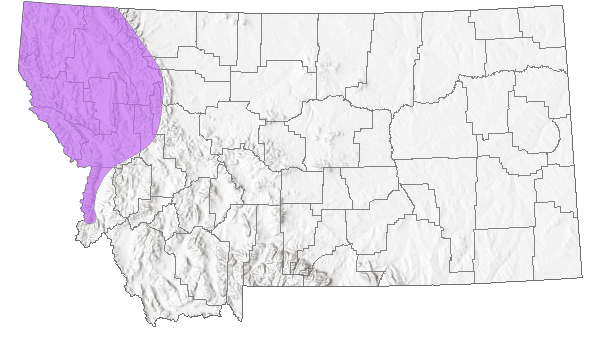
 Native
Native
Range Comments
Northern Idaho and adjacent northwestern Montana west of the Continental Divide (Burke 2013). In Montana, 54 records in seven counties: Flathead (7), Lake (5), Lincoln (15), Mineral (6), Missoula (8), Ravalli (3), Sanders (10). Elevation range is 675 to 1717 m (2215 to 5633 ft). The original description was based on animals from near Coeur d’Alene Lake, Kootenai County, Idaho. Up to 16 individuals were found at one Lincoln County site in mid-October. There is only one (unpublished) record of this species from Montana prior to 2004 (Hendricks 2012).
Observations in Montana Natural Heritage Program Database
Number of Observations: 69
(Click on the following maps and charts to see full sized version)
Map Help and Descriptions
Relative Density
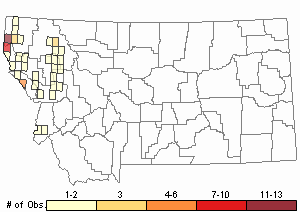
Recency
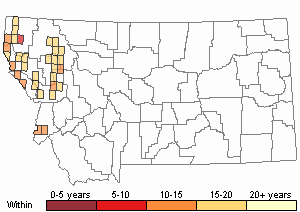

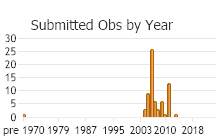
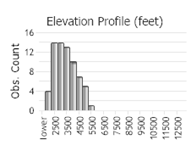 (Observations spanning multiple months or years are excluded from time charts)
(Observations spanning multiple months or years are excluded from time charts)
Migration
No information.
Habitat
Mostly in mesic mixed conifer forest, often relatively close to water. Canopy species include western redcedar, western hemlock, grand fir, Douglas-fir, Engelmann spruce, subalpine fir, ponderosa pine, black cottonwood, paper birch, aspen, western larch, and lodgepole pine, with secondary canopy sometimes including alder, dogwood, willow, Pacific yew, and hawthorn. Usually found under woody debris and leaf litter or in downed rotten wood, sometimes under rocks (Hendricks 2012).
Food Habits
No information.
Ecology
The posterior part of the foot can be dropped (autotomized), much as in lizards, as a defense against predator attack; small individuals sometimes drop their tails while being held in-hand, and the dropped tails may continue to wiggle for over an hour (Hendricks 2012).
Reproductive Characteristics
Hermaphroditic, based on internal anatomy (Pilsbry 1948).
Stewardship Responsibility
Threats or Limiting Factors
Habitat occupied by Prophysaon humile (moist sites in moderate elevation mixed conifer forest, often in valley bottoms) is threatened by logging, mining, fire, and rural home development, and possibly weed control (Frest and Johannes 1995). The impact of fire retardant and herbicides on this species and other terrestrial mollusks is unknown. Little is known about the biology of this species, including its sensitivity to disturbance.
References
- Literature Cited AboveLegend:
 View Online Publication
View Online Publication Burke, T. E. 2013. Land snails and slugs of the Pacific Northwest. Corvallis, OR: Oregon State University Press. 344 p.
Burke, T. E. 2013. Land snails and slugs of the Pacific Northwest. Corvallis, OR: Oregon State University Press. 344 p. Frest, T.J. and E.J. Johannes. 1995. Interior Columbia Basin mollusk species of special concern. Final report to the Interior Columbia Basin Ecosystem Management Project, Walla Walla, WA. Contract #43-0E00-4-9112. 274 pp. plus appendices.
Frest, T.J. and E.J. Johannes. 1995. Interior Columbia Basin mollusk species of special concern. Final report to the Interior Columbia Basin Ecosystem Management Project, Walla Walla, WA. Contract #43-0E00-4-9112. 274 pp. plus appendices. Hendricks, P. 2012. A Guide to the Land Snails and Slugs of Montana. A report to the U.S. Forest Service - Region 1. Montana Natural Heritage Program, Helena, MT. vii + 187 pp. plus appendices.
Hendricks, P. 2012. A Guide to the Land Snails and Slugs of Montana. A report to the U.S. Forest Service - Region 1. Montana Natural Heritage Program, Helena, MT. vii + 187 pp. plus appendices. Pilsbry, H.A. 1948. Land Mollusca of North America (north of Mexico), Volume II Part 2. The Academy of Natural Sciences of Philadelphia Monograph Number 2(2): 521-1113.
Pilsbry, H.A. 1948. Land Mollusca of North America (north of Mexico), Volume II Part 2. The Academy of Natural Sciences of Philadelphia Monograph Number 2(2): 521-1113.
- Additional ReferencesLegend:
 View Online Publication
View Online Publication
Do you know of a citation we're missing? Cockerell, T.D.A. 1890. New northwestern slugs. The Nautilus 3:111-113.
Cockerell, T.D.A. 1890. New northwestern slugs. The Nautilus 3:111-113. Deyrup-Olsen, I., A.W. Martin, and R.T. Paine. 1986. The autotomy escape response of the terrestrial slug Prophysaon foliatum (Pulmonata: Arionidae). Malacologia 27:307-311.
Deyrup-Olsen, I., A.W. Martin, and R.T. Paine. 1986. The autotomy escape response of the terrestrial slug Prophysaon foliatum (Pulmonata: Arionidae). Malacologia 27:307-311. Frest, T.J. and E.J. Johannes. 2001. An annotated checklist of Idaho land and freshwater mollusks. Journal of the Idaho Academy of Science 36(2):1-51.
Frest, T.J. and E.J. Johannes. 2001. An annotated checklist of Idaho land and freshwater mollusks. Journal of the Idaho Academy of Science 36(2):1-51. Hendricks, P. 2005. Surveys for animal species of concern in northwestern Montana. Unpublished report to the Montana Department of Fish, Wildlife & Parks, Montana Natural Heritage Program, Helena, Montana, May 2005. 53 p.
Hendricks, P. 2005. Surveys for animal species of concern in northwestern Montana. Unpublished report to the Montana Department of Fish, Wildlife & Parks, Montana Natural Heritage Program, Helena, Montana, May 2005. 53 p. Hendricks, P., B.A. Maxell, and S. Lenard. 2006. Land mollusk surveys on USFS Northern Region lands. A report to the USDA Forest Service, Northern Region. Montana Natural Heritage Program, Helena, Montana. 11 pp. plus appendices.
Hendricks, P., B.A. Maxell, and S. Lenard. 2006. Land mollusk surveys on USFS Northern Region lands. A report to the USDA Forest Service, Northern Region. Montana Natural Heritage Program, Helena, Montana. 11 pp. plus appendices. Hendricks, P., B.A. Maxell, S. Lenard, and C. Currier. 2007. Land mollusk surveys on USFS Northern Region lands: 2006. A report to the USDA Forest Service, Northern Region. Montana Natural Heritage Program, Helena, Montana. 11 pp. plus appendices.
Hendricks, P., B.A. Maxell, S. Lenard, and C. Currier. 2007. Land mollusk surveys on USFS Northern Region lands: 2006. A report to the USDA Forest Service, Northern Region. Montana Natural Heritage Program, Helena, Montana. 11 pp. plus appendices.
- Web Search Engines for Articles on "Smoky Taildropper"
- Additional Sources of Information Related to "Snails / Slugs"





